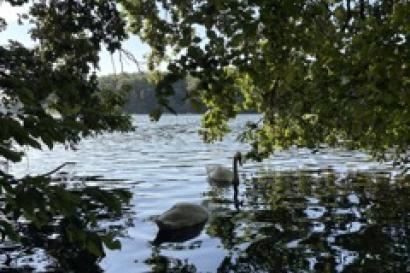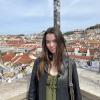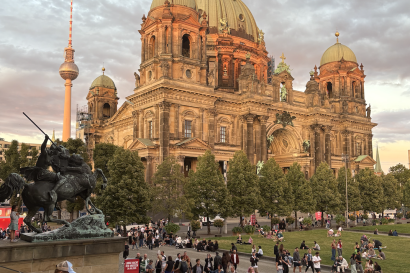This post marks my second round of exploits into Berlin’s theater scene. I thought I had experienced the avant garde already; the open air production of Midsummer Night’s Dream and the paint-flinging, chalkboard-happy Enemy of the People were, until recently, the most experimental works of theater I’d ever seen. This past weekend, however, I saw an entirely new side of Berlin theater—an excitingly bizarre side.
On Saturday night, a group of friends and I went to our first opera. When I first heard about it, I knew from the 13 euro ticket price not to expect a chandelier-filled atrium with ushers in suits and a full orchestra, but I similarly didn’t think I’d be led to an abandoned church with a light show projected onto its alter, flashing different neon images in time with the music. The theme of the opera was “walls” and it reminded me a little of Disney’s Fantasia. Singers, dancers, and actors kept popping out of unlikely places and glowing different bright colors as the symphony of lights performed directly on their bodies.
The following evening, I returned to the Shaubrune to see Romeo and Juliet. This production placed the characters in an ambiguous, ultra-contemporary setting and every set piece gave the scenes an industrial, dreamlike quality. The show opened with a miniature cityscape made out of cardboard boxes, and took us in turn to Juliet’s plywood bedroom papered with a collage of magazine clippings, a rowboat in a sea of blue plastic waves, and a rave complete with giant animal heads and people dressed as sparkly bodily organs. Actors threw confetti, squirted long streams of watery blood, and spilled mouthfuls of food all dressed in starched ruffs that got increasingly filthy throughout the show. The costumes ranged from Juliet’s wedding dress which took up the entire stage and had to be removed for the curtain call, to a man and woman in matching pageboy haircuts sharing one enormous sweater and pair of metallic pants, to a singer whose top was nothing but two ink handprints over her chest. The actors’ dressing rooms sat right on stage, and a two-person screaming metal band narrated the show.
All these strange features combined might read as an off-putting cacophony and a hot mess rather than a work of professional theater but somehow, I thought it worked. I recognized the play as Romeo and Juliet but was still always excited to see what would happen next, what strange new directions the scenes would go, and what unique new vignettes would be created. It whet my imagination and made me excited to see more theater—although something tells me the Russian Ballet’s production of Swan Lake (which we see next week in St. Petersburg) will be cut of a somewhat different cloth.

Alli Green
<p><span style="color: rgb(29, 29, 29); font-family: Arial, Verdana, sans-serif; font-size: 12px; line-height: normal; background-color: rgb(237, 237, 237);">Having grown up in rural Vermont, Alli Green now studies art history and studio art at Skidmore College. She stays active on campus by working as admissions ambassador, a tutor in Skidmore’s writing center, and looks forward to assistant costume designing the theater department’s main stage production in the spring of 2014. Her ambitions include pursuing a master’s degree in either art history, museum studies, or library sciences, exploring opportunities to work as a field archeologist, illustrating children’s books, and contributing to the making of movie magic as a costume designer or special effects makeup artist. In the meantime, she is content to get excited about books, movies, art, history, and learning everything she can both while she is a student and after.</span></p>





